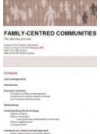This brief literature review explores families-centred community models. It set out to determine the key components of family-centred communities from the literature. The review contributed to an initiative by the Commission to encourage councils to take a family-centred approach to planning and decision-making.
Purpose
This review set out to determine the key components of family-centred communities from the literature. It will contribute to an initiative by the Commission to encourage councils to take a family-centred approach to planning and decision-making. The report will also provide the Families Commission with knowledge about family-centred communities for future use.
Methodology
The following process was used in order to ensure extensive coverage of the area:
- Literature on family-centred communities and family-centred policy development was sourced initially through web searches on key words and phrases. Where literature could not be accessed online, it was primarily sourced through libraries and relevant organisations.
- Relevant local government documentation on policy-proofing was reviewed.
- Other relevant literature on the impact local government can have on families was reviewed.
To prevent the literature review from becoming unmanageable, four basic criteria were applied to the inclusion or exclusion of texts:
- Materials must be in English.
- Literature must focus on New Zealand or other English-speaking countries, such as Australia, Canada, the United States and the United Kingdom.
- Literature must have been produced in the last 10 years (that is, the review went back to 1997, with exceptions for key documents).
- Materials must be published or publicly available either online, through accessible libraries, from the originating commissioning or other organisation or through booksellers.
It should be noted that there is a general dearth of materials available on family-centred communities and family-centred community development. Web and library searches revealed early on in the study that there is very little written on this subject. Furthermore, there is little material available on tools or processes that assess the impact of local government policies on families. The literature available tended to interpret ‘family’ as parents with children, with little recognition of other family forms. This reinforced the need for the Families Commission’s research.
There is a richer body of literature when one moves beyond the particular issue of family-centred communities to issues of community wellbeing. Similarly, when one moves beyond the particular issue of family wellbeing to the wellbeing of individuals and the population groups within families (for example, children, young people and older people), there is a richer body of literature. Web and library searches revealed thousands of documents on these subjects. There is also literature on how community and neighbourhood factors affect these population groups. However, this literature was considered to be beyond the scope of the research.
Key Results
Councils are well placed to influence the development of family-centred communities and to enhance family wellbeing. They have a role in providing or planning the services that families’ everyday activities are dependent on. They also have a role in influencing the activities of other agencies. For example, councils facilitate the determining of community outcomes, which guide council planning and inform central government and others about community needs.
The literature review suggests that some processes are central to ensuring local government achieves family-centred outcomes. These do not provide a simple checklist of tasks to carry out during decision-making, but rather challenge the fundamental premisses upon which decisions are made.
On the basis of the literature review, this report suggests that councils adjust the following frameworks to ensure they include concepts of family wellbeing:
- wellbeing frameworks – to ensure they capture family wellbeing (the wellbeing of the family itself, over and above the wellbeing of individual family members)
- indicators frameworks – to ensure they include measures of family wellbeing
- community outcomes frameworks – to ensure they include explicit outcomes for families.
The report also suggests that councils should include families in some of their day-to-day processes, and that this inclusion should reflect the diversity of family structures in their communities.
Councils make local decisions about their communities’ needs and priorities. A family-centred approach would involve applying councils’ considerable skills and experience in public consultation and community engagement in an effort to target families.
The literature suggested that a family-centred approach would not only require collaboration between councils and other external parties but also collaboration across council functional areas.

